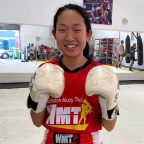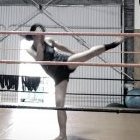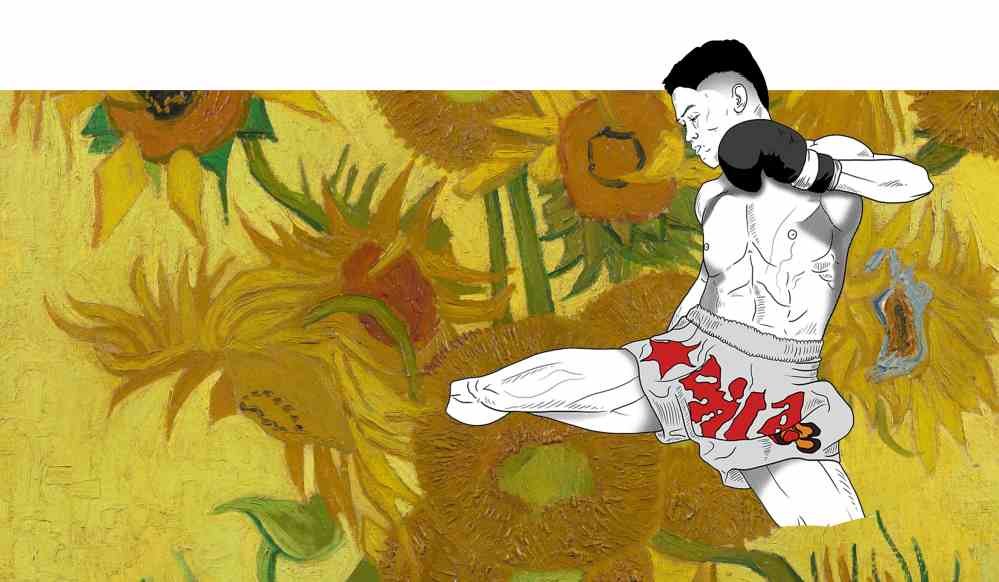Leaderboard
Popular Content
Showing content with the highest reputation on 10/21/2021 in all areas
-
the illustration above is of Karuhat done by graphic artist Luis Pinto, layered over a Van Gogh At bottom of this post is a segment from a ways back where Sylvie and I touched on some thinking I've had that placed Muay Thai, the art of Muay Thai, as one of the great Art Forms of our time. After reading this you can see the live thinking between the both of us on this. I for some time have tried to position Thailand's Muay Thai - and the all art forms of combat sports as well - in the context of other traditional fine art forms such a poetry, painting, dance, fiction, etc. The two bookends that we extemporaneously covered in the video below were the idea that Muay Thai (and full contact fighting arts), unlike almost all the others, is done under great duress. I think dance can be considered to be under something of intensity which is akin to duress, and we could talk about that as a special case, but the fighting arts, in so far they are arts, involve duress and bodily fear as the material, the paint and canvas, with which they paint. There is something quite special about this, I believe. The fighting arts are heroically expressing themselves at, in and on what can be thought of as the most base, or perhaps animal, in what is human. This canvas and paint is unique. The other bookend that is brought up below is that the art form of something like Thailand's Muay Thai, and maybe western boxing of the past when it was more composed of communities, is a Way of Life. Which means that it expresses something more than techniques, or excellence. It comes out of lives, values and culture, in a weave that makes it incredibly rich. Rich in an artistic way. I compare it to something like Fishing, which may be considered a craft, which also traditionally is a body of practices and techniques which are embedded in a Way of Life which might express the lives of an entire village. I'm purposely blurring the lines of craft and art here, largely because "art" usually resides in the hands of the privileged, and as we move along the spectrum towards craft we encounter the knowledge and practices of a people. How much of qualifies as Art is part of the question as to whether Muay Thai is a great Art Form, or even an Art Form at all. Given enough historical perspective individual art is understood to be an expression of a people in a historical time, such as the art of the Incas, the tragedies of the Greeks, the Impressionism of late 19th century Europe. Core to this perspective is raising an appreciation for what combat sports is, the position they have within a society, and laying some claim to the importance of the aesthetics of the combat sport performance. This dimension of fight aesthetics is what elevates fighting to an Art in the societal sense, I'd suggest, in the same way that painting or poetry can possess inherent expressive value, to the culture itself. This means that western boxing, the world's MMA and other combat sports have a claim to artistic value, even though they also ride hard the lines of commerce, popular culture and arguably the role of sheer spectacle, in the "bread and circuses" sense - see Noam Chomsky for that perspective. Perhaps like cinema, the fighting arts in sport operate between entertainment and art, which isn't to deny film or fighting its real value as an Art itself. This post just wanted to spin out some of those developing ideas, and in thinking about Thailand's Muay Thai explain why I believe it may be the greatest art form in the world. This isn't to say that it is better than poetry, or dance...or better than western boxing or Karate, but rather in a specific way see all the differing threads that it brings together into a single rope, that make of it something that is extraordinarily rich. That we raise up the importance of fighting arts themselves along with this discussion is also a benefit. To start with, one thing that arguably separates out Thailand's Muay Thai are the firm aesthetic demands that it places on scoring. For some this might make Muay Thai somewhat unreal as a fighting sport, because it's not all about the damage - though it clearly is one of the more violent combat sports on the planet, its full-rules version not even legal in many countries. Muay Thai has a unique combination of very visible violence, but also strong aesthetic guidelines. Things like fighter posture, displays of balance, self-control figure heavily on the scorecard, as well as the ability to express oneself narratively throughout the 5 rounds - narrative itself is the real of many of the fine arts (for more on narrative time in Thailand's Muay Thai see: The 6 Core Aspects of Muay Thai). Fighting in Thailand is expressly, even in terms of score, storytelling. (I believe fighting is also storytelling in other combat sports, in terms of audience appreciation, but this valuation is not expressly embedded in scoring criteria). Muay Thai advocates might say that these aesthetic principles in scoring are actually encoded guidelines for real fighting prowess, so that if you excel in balance, posture, artful dominance, narrative, you become a very effective fighter in the raw sense, but, it is really that there is a strong aesthetic demand that allows Thailand's Muay Thai to ascend up the pyramid of combat sports, as an Art. It is, or has a strong artistic aspect. And if it has a differential of artistic quality from some combat sports, it also distinguishes itself from more "traditional martial arts" that went through long periods of development apart from large volume full contacting fighting, in the hands of masters or teachers who perhaps somewhat aesthetically carved & preserved fighting skills. Thailand's Muay Thai exists pretty much baby bear between let's say western boxing and 1980 Korea's TKD. The product of 100,000s of full contact fights - determining its grounded efficacy - while maintaining an expression of the culture and the people out of which it has sprung, purposely. It is Buddhistic and artistic, but also it is quite reality tested, made from the lab of full-contact physically clashing, highly trained bodies. It's important to understand because people in combat sports, and traditional martial arts like to argue about which fighting form is superior, in some kind of abstract, almost technical way, as if you could take a blank fighter in art x, and a blank fighter in art y and come out with which art is better. Aside from that being not very close to how real fighting knowledge works, this is not what this is about. And, this is not about badassness, or technical proficiency. Nope. It's thinking about the Art value of Muay Thai, and other fighting sports and arts in general. And in terms of Thailand's Muay Thai, thinking about all the ways that information, distinction, criteria, belief, aesthetic ambition and experience come to be expressed through it, in real world fighting stages. Like other arts, fighting arts are staged. In a way, it's about all the influences of value that are poured into the expression of Thailand's Muay Thai, let's say over the last 100 years of its modernity. Its how much variation and richness, and portrayed human efficacy can be packed into a fighting art and its real world practice, so that we value it artfully, such that a comparison with the Fine Arts becomes interesting. In my mind, in the modern era, the West's culture of boxing say between the 1930s and 1980s is the closest thing I think of, a performed knowledge and rite, flowing out of specific communities & micro-economies that reached very high levels of skilled excellence, somewhat in parallel to Thailand's Muay Thai. The main difference between the two, in terms of Art Form evaluation, is perhaps the aesthetic dimension of Thailand's scoring criteria, the way that its Muay Thai reaches deeper into performance as art, explicitly, though it would be very interesting to talk about the evolving, often unstated aesthetic demands of boxing throughout its history in the West. There is a deeper dimension of the argument towards an Art, which I've begun talking about in this running short essay series (just below), which attempts to uncover some of the deeper cultural reasons why combat sports themselves carry so much meaning in a culture. They are not just "bread and circuses", but following the thinking of the sociologist René Girard - wikpedia here - who has studied the logic of Sacrifice and victim, they may serve a powerful purpose in equalizing and stabilizing a society or subculture. Much as older rights of sacrifice may have purged a community of inherent violence, combat arts that necessarily produce losers may very well be fulfilling a much older human sociological need. You can read into that possibility as it applies to Thailand's Muay Thai in my unfinished series here: This is explicitly not to say that Thailand's Muay Thai alone might fulfill this role, in fact almost any sporting event that produces losers (and winners) might be performing this role. But, it is to add importance to the kinds of things that are being expressed by the fighter/artist in the ring, an importance that the writers of history gift to the Fine Arts of the academies. Art is supposed to be transformative, expressive and illuminating, with roots into human rite and ritual. It may very well be that combat sports indeed are creating some of these same values, but perhaps in an older way. If we add the aesthetic dimensions that Thailand's Muay Thai folds back in, we can see the unique nexus of kinds value that may be braided. It is the very agonistic nature of the performance, the way that adrenaline, blood, fear, Amygdala, technique, self-possession, Buddhism, pain, recovery and respect mix that make of this art and sport at the very least a spectacular art. It's woven of extremely diverse strains of what makes us human, from the very lowest to the most high. And, as mentioned up top, it is not a rarefied art held by "masters". It exists in a living sense in households, community centers, in family relations, in circles and roots of micro-economies, a thick web of a turf of Life, perhaps how fishing or sailing as an art and craft might inhabit a coastal peoples for a century, expressing them. Filled with practical, hard-won knowledge, and also meaningfully imbued practices, the things that cut off the "artist" in the prototypical sense, are re-grounded in the lives of people, and all their beliefs. It's true. The Muay Thai of Thailand is changing. It could be said that the fabric of which it is woven is unraveling, however slowly or quickly we may not be able to tell, but it is still there before us right now, a certain kind of inheritance. It's the inheritance of a people, the Thai people, but it also I believe the inheritance of the world, because so much of Muay Thai has involved deep international influences, starting with Western Boxing and to a lesser degree Judo at the birth of its modernity in the 1920s. For a 100 years this art form has been catching the strands of the world's fighting arts and woven them into the tapestry, as well. It's okay if it's not acknowledge as the greatest Art Form in the World, but I do want the very idea of Art Form to be expanded to include the fighting arts, and for aesthetic concerns in a fighting sport to gain some weight when we think of the value of what is being done. It may mean something to us to understand that the fighting arts are performing something primally important to us, and that they are doing it both artfully and brutally. The Muay Thai Bones segment:1 point
-
This post cannot be displayed because it is in a password protected forum. Enter Password
-
This post cannot be displayed because it is in a password protected forum. Enter Password
Footer title
This content can be configured within your theme settings in your ACP. You can add any HTML including images, paragraphs and lists.
Footer title
This content can be configured within your theme settings in your ACP. You can add any HTML including images, paragraphs and lists.
Footer title
This content can be configured within your theme settings in your ACP. You can add any HTML including images, paragraphs and lists.



.thumb.jpg.dd931b597cfd06ca3984760cf2858db2.jpg)